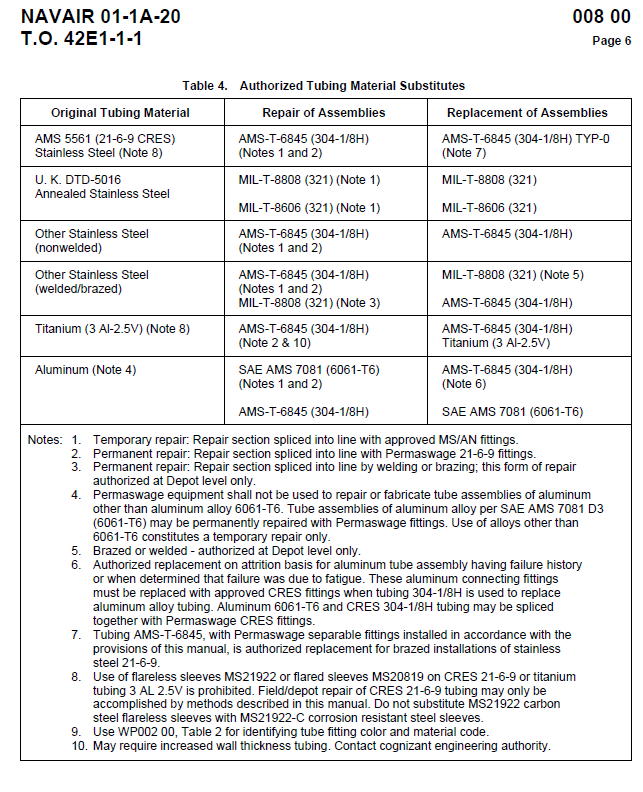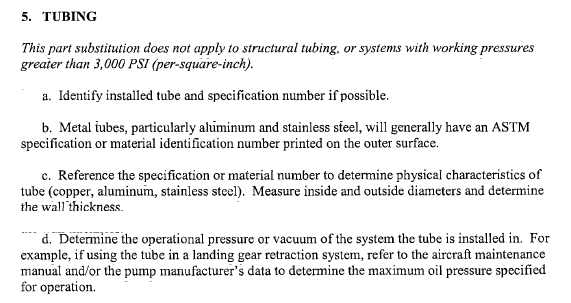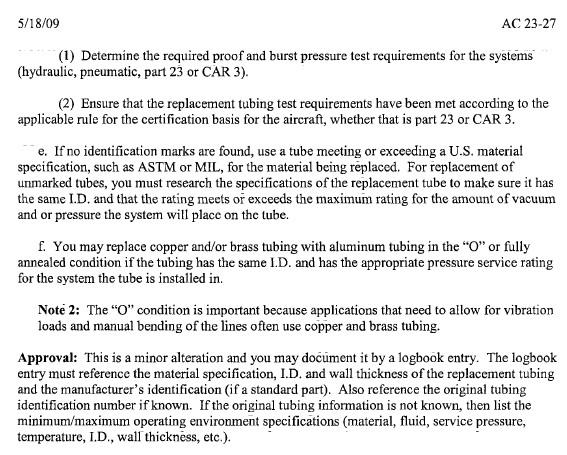Navigation
Install the app
How to install the app on iOS
Follow along with the video below to see how to install our site as a web app on your home screen.
Note: This feature may not be available in some browsers.
More options
Style variation
-
Congratulations TugboatEng on being selected by the Eng-Tips community for having the most helpful posts in the forums last week. Way to Go!
You are using an out of date browser. It may not display this or other websites correctly.
You should upgrade or use an alternative browser.
You should upgrade or use an alternative browser.
replacement of aluminum hydraulic lines with CRES 5
- Thread starter brin
- Start date
- Status
- Not open for further replies.
-
1
- #2
Substituting cres for 6061-T6 alum hydraulic pressure lines seems a bit odd. There would be many differences between the two materials to consider, such as stiffness, CTE, thermal conductivity, galvanic compatibility, etc. The flared tube seal interface would require cres tube and cres fittings for proper galvanic compatibility.
- Thread starter
- #3
yes, from a material change standpoint this can get complicated depending on the environment (vibration, chemical exposure, temperature, etc.). I have a NAVAIR 01-1A-20 document that suggests this is a common practice. But I would like to see if any other operators or manufactures allow the use of CRES as alternate to aluminum before going further. The NAVAIR document is a generic maintenance manual and is not exactly specific to one acft model.
I took a quick glance thru the NAVAIR Tech manual you noted, and I'm assuming you are referring to sec. 008 00 table 4 shown below. Footnote 4 seems to indicate the aluminum tube itself may be replaced on a temporary basis with AMS-T-6845 cres. But footnote 6 seems to require any permanent repair made with cres tube to also include replacing all connecting fittings with approved cres parts.
There is also the following notation on page 3 of the same section: "NOTE - CRES tubing AMS-T-6845 (304-1/8H) is a suitable substitute for all aluminum alloy tubing when 6061-T6 is unavailable. This does not apply to aluminum alloy low pressure LOX systems. Replacement tubing for low pressure liquid oxygen systems shall be aluminum alloy only."

On another thread you were inquiring about material substitution of some airframe rivets being used to restore a vintage aircraft. wktaylor directed you to FAA AC 23-27 which provides guidance on obtaining approval for material/component substitutions when the original material/component is no longer available. For your particular situation you can use the NAVAIR tech manual as the basis for making this substitution, and I don't think you'll have any trouble getting approval. Provided of course that you can demonstrate the 6061-T6 tube material is "unavailable".
Hope that helps, and good luck with your project.
Terry
There is also the following notation on page 3 of the same section: "NOTE - CRES tubing AMS-T-6845 (304-1/8H) is a suitable substitute for all aluminum alloy tubing when 6061-T6 is unavailable. This does not apply to aluminum alloy low pressure LOX systems. Replacement tubing for low pressure liquid oxygen systems shall be aluminum alloy only."

On another thread you were inquiring about material substitution of some airframe rivets being used to restore a vintage aircraft. wktaylor directed you to FAA AC 23-27 which provides guidance on obtaining approval for material/component substitutions when the original material/component is no longer available. For your particular situation you can use the NAVAIR tech manual as the basis for making this substitution, and I don't think you'll have any trouble getting approval. Provided of course that you can demonstrate the 6061-T6 tube material is "unavailable".
Hope that helps, and good luck with your project.
Terry
-
3
- #5
Brin...
Tbuelna pretty much found the correct table in USAF T.O. 42E1-1-1 [NAVAIR 01-1-20]... and it authorizes this substitution for fluid systems.
I think several elements are in-play here… assuming weight is not a factor/penalty.
CRES hydraulic 304--Annealed or 1/8H tubing has ~same operating limits as 6061-T6, but with somewhat better tolerance for handling-damage and fatigue.
CRES hydraulic tubing and fittings are probably a little easier for an inexperienced technician to handle form and assemble... especially for smaller tubing ODs.
I used to fuss over the corrosion potential until I realized that CRES tubing and fittings usually have a very small contact area with mating aluminum parts. This contact area is usually saturated with hydraulic fluid [in-tube... or when used as an assembly lubricant, IE: T.O. emphasizes assembling tubing joints "wet" with oil or hydraulic fluid] and are sealed-off from air-contact. Also, EXCEPT for the aluminum tubing, all aluminum sleeves, nuts and fluid fittings are anodized… which is a pretty decent protective barrier when combined with fluid for lubrication… against CRES.
NOTE. CRES [high nickel alloy] is very dissimilar to aluminum [especially when passivated]. The protective films and the oil lubricants help keep the aluminum from corroding.
NOTE. I do remind mechanics that different alloys usually have different assembly torque-tightening requirements... be careful/gentle during mixed-metal [and all] hydraulic system component Install.
I have also been approached about Installing CRES sleeves/nuts on aluminum tubing; or on-rare occasions, VV: aluminum sleeves/huts on CRES tubing. I am very wary of these combinations and rarely allow them without deep thought and attention to local environment, other assembly details, etc.
Recently I had shop ask to install a CRES bulkhead nut on a steel fluid fitting [at a web-pass-thru hole], in-lieu-of the specified aluminum ‘B-Nut’ [which tends to strip-the-nut threads when torqued-up: I’m sure there is another issue about training/precision installation of fluid fittings, here]. I OK’ed the substitution with two caveats: an anodized aluminum washer [0.016 thick] MUST be used against the bulkhead web to prevent damage and then corrosion due to the CRES nut] ; and torque-tables be consulted to verify actual torque requirements. I’m not sure the shop was ready for that lengthy answer.
PS: O2 or LO2 tubing assemblies require a whole different level of precision/attention due to the explosive nature of pure Oxygen.
PS: Be careful about matching 6061-T6 tubing and 304-1/8H tubing wall thickness. Fluid fitting have some what similar ratings, but aluminum tubing/fittings/parts can be more sensitive to forming/assembly damage. PROOF PRESSURE TEST all newly manufactured fluid tube asssys!!!
Regards, Wil Taylor
o Trust - But Verify!
o We believe to be true what we prefer to be true.
o For those who believe, no proof is required; for those who cannot believe, no proof is possible.
o Unfortunately, in science what You 'believe' is irrelevant. ["Orion"]
o Learn the rules like a pro, so you can break them like an artist. [Picasso]
Tbuelna pretty much found the correct table in USAF T.O. 42E1-1-1 [NAVAIR 01-1-20]... and it authorizes this substitution for fluid systems.
I think several elements are in-play here… assuming weight is not a factor/penalty.
CRES hydraulic 304--Annealed or 1/8H tubing has ~same operating limits as 6061-T6, but with somewhat better tolerance for handling-damage and fatigue.
CRES hydraulic tubing and fittings are probably a little easier for an inexperienced technician to handle form and assemble... especially for smaller tubing ODs.
I used to fuss over the corrosion potential until I realized that CRES tubing and fittings usually have a very small contact area with mating aluminum parts. This contact area is usually saturated with hydraulic fluid [in-tube... or when used as an assembly lubricant, IE: T.O. emphasizes assembling tubing joints "wet" with oil or hydraulic fluid] and are sealed-off from air-contact. Also, EXCEPT for the aluminum tubing, all aluminum sleeves, nuts and fluid fittings are anodized… which is a pretty decent protective barrier when combined with fluid for lubrication… against CRES.
NOTE. CRES [high nickel alloy] is very dissimilar to aluminum [especially when passivated]. The protective films and the oil lubricants help keep the aluminum from corroding.
NOTE. I do remind mechanics that different alloys usually have different assembly torque-tightening requirements... be careful/gentle during mixed-metal [and all] hydraulic system component Install.
I have also been approached about Installing CRES sleeves/nuts on aluminum tubing; or on-rare occasions, VV: aluminum sleeves/huts on CRES tubing. I am very wary of these combinations and rarely allow them without deep thought and attention to local environment, other assembly details, etc.
Recently I had shop ask to install a CRES bulkhead nut on a steel fluid fitting [at a web-pass-thru hole], in-lieu-of the specified aluminum ‘B-Nut’ [which tends to strip-the-nut threads when torqued-up: I’m sure there is another issue about training/precision installation of fluid fittings, here]. I OK’ed the substitution with two caveats: an anodized aluminum washer [0.016 thick] MUST be used against the bulkhead web to prevent damage and then corrosion due to the CRES nut] ; and torque-tables be consulted to verify actual torque requirements. I’m not sure the shop was ready for that lengthy answer.
PS: O2 or LO2 tubing assemblies require a whole different level of precision/attention due to the explosive nature of pure Oxygen.
PS: Be careful about matching 6061-T6 tubing and 304-1/8H tubing wall thickness. Fluid fitting have some what similar ratings, but aluminum tubing/fittings/parts can be more sensitive to forming/assembly damage. PROOF PRESSURE TEST all newly manufactured fluid tube asssys!!!
Regards, Wil Taylor
o Trust - But Verify!
o We believe to be true what we prefer to be true.
o For those who believe, no proof is required; for those who cannot believe, no proof is possible.
o Unfortunately, in science what You 'believe' is irrelevant. ["Orion"]
o Learn the rules like a pro, so you can break them like an artist. [Picasso]
-
1
- #6
brin-
I did a quick review of FAA AC 23-27. Below is the relevant section on tubing material substitutions for hydraulic systems with working pressure <3000psi. Apparently it is considered a "minor alteration" and can be handled with detailed documentation of the substitution in a log book entry.


Hope that helps.
Terry
I did a quick review of FAA AC 23-27. Below is the relevant section on tubing material substitutions for hydraulic systems with working pressure <3000psi. Apparently it is considered a "minor alteration" and can be handled with detailed documentation of the substitution in a log book entry.


Hope that helps.
Terry
- Thread starter
- #7
- Status
- Not open for further replies.
Similar threads
- Replies
- 4
- Views
- 5K
- Replies
- 9
- Views
- 12K
- Replies
- 10
- Views
- 7K
- Replies
- 15
- Views
- 1K
- Replies
- 7
- Views
- 6K
